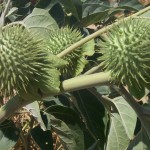Jimsonweeds, Thorn-apples , Angel Trumpet
Datura spp.
Solanaceae (Nightshade family)
Description
Several species of Jimsonweeds grow in Texas, all appearing very similar. They are coarse-looking, ill-scented, herbaceous annual weeds of the nightshade family. The very distinctive flowers are large, showy, erect, solitary and white or purplish and may appear from April to October. Flowers grow in the leaf axils. Leaves are alternate, simple, hairless and toothed. Except that they are larger, the seedpods resemble those of cocklebur, being a spiny capsule up to 2 inches long. The fruit contains four compartments and holds as many as 100 seeds. Although all parts of the plant are poisonous, the leaves and seeds contain the highest concentration of toxins.Habitat
Jimsonweeds are distributed widely throughout Texas and the United States. They normally grow in rich soils on disturbed sites, waste places, old fields, floodplains, and in open areas.Toxic Agent
Toxicity results from tropane alkaloids (atropine, scopolamine, hyoscyamine). Livestock and people can be poisoned by eating any part of the plant, including the seeds. Consumption of as little as 10 ounces of the plant, or less than 0.1 percent of the body weight of the animal, can kill cattle. Many humans have been poisoned by eating the seeds, unripe seed pods, and flowers. The plants have been ingested for their hallucinogenic effects.Signs of Livestock Ingestion
Signs of poisoning are similar for both humans and livestock. Clinical signs include: Intense thirst; Distorted vision; Uncoordinated movement; High body temperature; Rapid and weakened heartbeat; Dilated pupils; Convulsions; Coma and death; Urinary retention; Vomiting/regurgitation.Management Strategies
No medicinal treatments are specified for poisoned livestock, although stimulants such as pilocarpine and physostigmine have been used. Some poisoned animals may recover if they are hand-fed a suitable diet and provided good quality water. Jimsonweeds are extremely unpalatable to livestock and poisoning occurs only rarely. When it does occur, it is usually because hungry livestock are confined where plants are found. Grubbing or herbicides easily control this plant. Exercise caution when treating jimsonweed with 2,4-D, as it makes the plant more palatable.Images
Plant Characteristics
Flower Color: White
Seed Type: Fruit/Berry
Duration: Annual
Stem Texture: Hairless/Smooth
Growth Habit: Forbs/Broadleaf
Leaf Shape
 : Simple with Pinnate or Parallel Venation
: Simple with Pinnate or Parallel Venation
Season: Warm
Distribution
 : 03 - Post Oak Savannah, 04 - Blackland Prairies, 05 - Cross Timbers and Prairies, 06 - South Texas Plains, 07 - Edwards Plateau, 08 - Rolling Plains, 09 - High Plains, 10 - Trans-Pecos
: 03 - Post Oak Savannah, 04 - Blackland Prairies, 05 - Cross Timbers and Prairies, 06 - South Texas Plains, 07 - Edwards Plateau, 08 - Rolling Plains, 09 - High Plains, 10 - Trans-Pecos
Distributions
Distribution refers to the ecological region in Texas that a plant has been found. You can also view a clickable map.
Book: Toxic Plants of Texas (B-6105)
Collection: Toxics, Wild Flowers
Livestock Affected: Cattle, Goats, Horses, Pigs, Poultry, Sheep
Livestock Signs: Abnormal Heartbeat, Coma, Convulsions, Dilated Pupils, Distorted/Blurry Vision, High Body Temperature, Incoordination, Intense Thirst, Urinary Retention, Vomiting/Regurgitation





